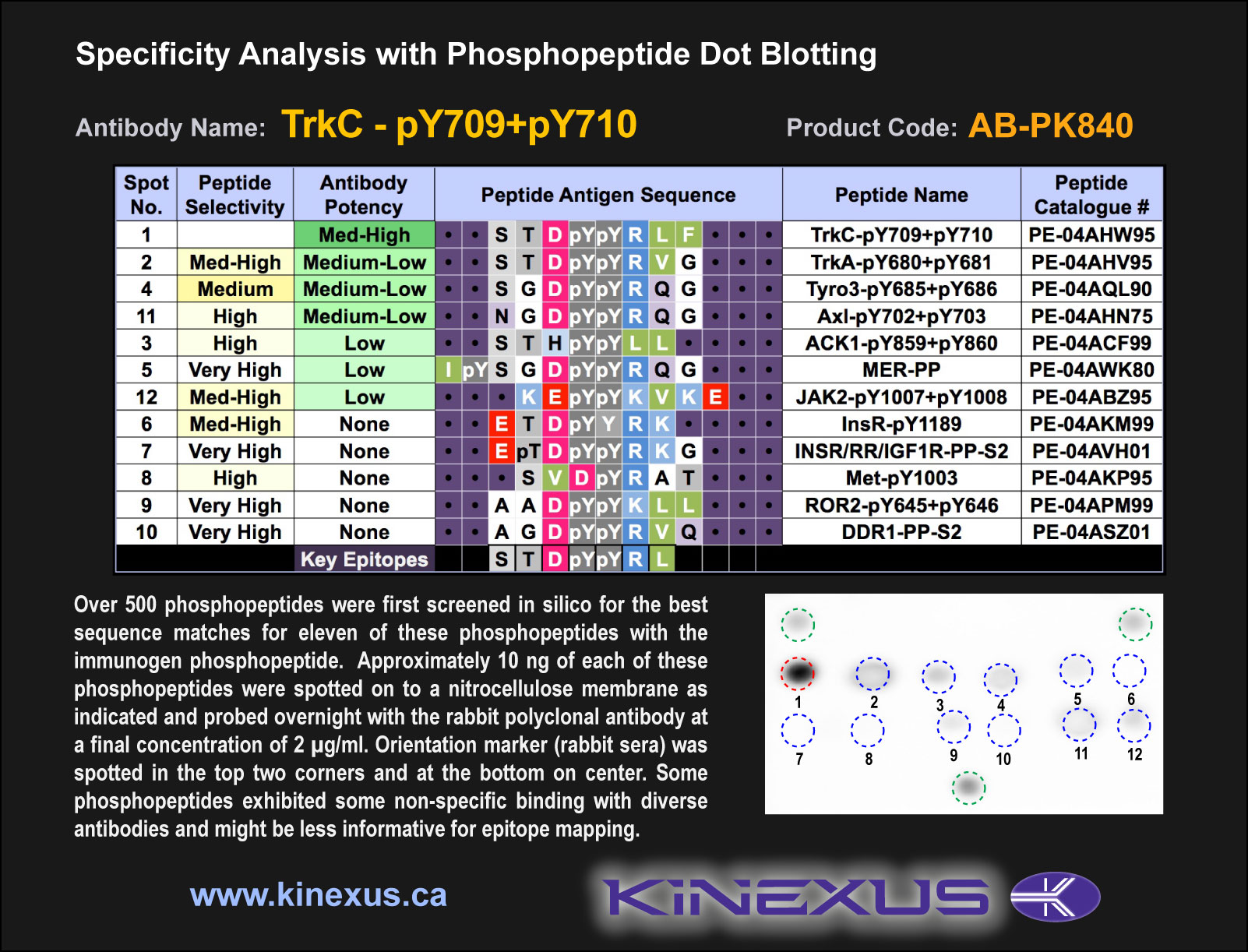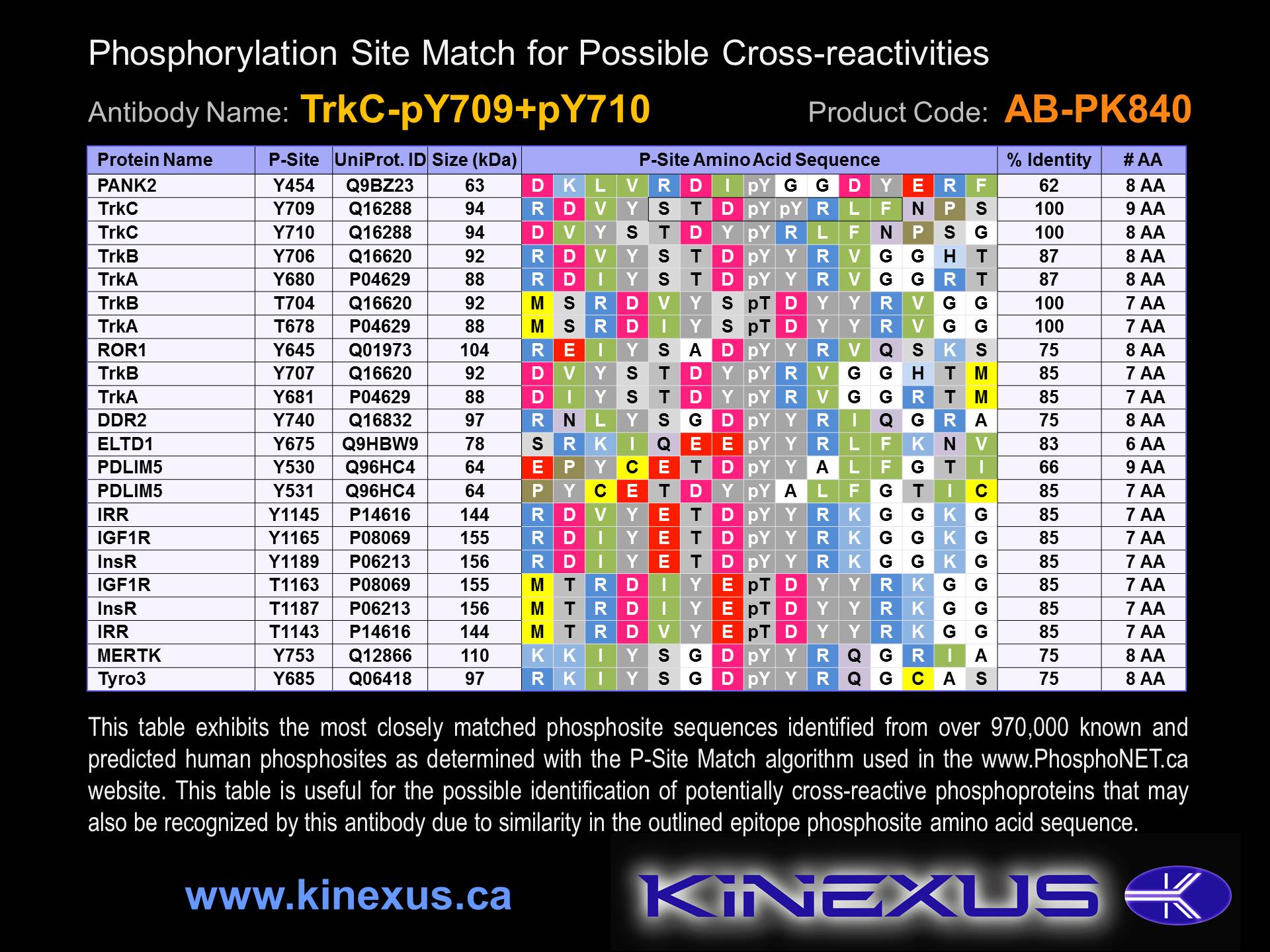Product Name: TrkC-pY709+pY710
Product Number: AB-PK840
| Size: | 25 µg | Price: | 89.00 | |
| $US |
Target Full Name: NT-3 growth factor receptor
Target Alias: GP145-TrkC; Kinase TrkC; Neurotrophic tyrosine kinase receptor 3; Neurotrophic tyrosine kinase, receptor, type 3; Neurotrophin-3 receptor non-catalytic isoform 1; NT-3 growth factor receptor; NTrk3; TrkC; TrkC tyrosine kinase; gp145(trkC); CCDS10340.1; ENSG00000140538
Product Type Specific: Protein kinase phosphosite-specific antibody
Antibody Code: PK840
Antibody Target Type: Phosphosite-specific
Antibody Phosphosite: Y709+Y710
Protein UniProt: Q16288
Protein SigNET: Q16288
Antibody Type: Polyclonal
Target Alias: GP145-TrkC; Kinase TrkC; Neurotrophic tyrosine kinase receptor 3; Neurotrophic tyrosine kinase, receptor, type 3; Neurotrophin-3 receptor non-catalytic isoform 1; NT-3 growth factor receptor; NTrk3; TrkC; TrkC tyrosine kinase; gp145(trkC); CCDS10340.1; ENSG00000140538
Product Type Specific: Protein kinase phosphosite-specific antibody
Antibody Code: PK840
Antibody Target Type: Phosphosite-specific
Antibody Phosphosite: Y709+Y710
Protein UniProt: Q16288
Protein SigNET: Q16288
Antibody Type: Polyclonal
Antibody Host Species: Rabbit
Antibody Immunogen Source: Human TrkC (NTrk3) sequence peptide Cat. No.: PE-04AHW95
Antibody Immunogen Sequence: STD(pY)(pY)RLF(bA)C
Antibody Immunogen Description: Corresponds to amino acid residues S706 to F713; In the protein kinase catalytic domain activation T loop region between subdomains VII and VIII.
Antibody Immunogen Source: Human TrkC (NTrk3) sequence peptide Cat. No.: PE-04AHW95
Antibody Immunogen Sequence: STD(pY)(pY)RLF(bA)C
Antibody Immunogen Description: Corresponds to amino acid residues S706 to F713; In the protein kinase catalytic domain activation T loop region between subdomains VII and VIII.
Production Method: The immunizing peptide was produced by solid phase synthesis on a multipep peptide synthesizer and purified by reverse-phase hplc chromatography. Purity was assessed by analytical hplc and the amino acid sequence confirmed by mass spectrometry analysis. This peptide was coupled to KLH prior to immunization into rabbits. New Zealand White rabbits were subcutaneously injected with KLH-coupled immunizing peptide every 4 weeks for 4 months. The sera from these animals was applied onto an agarose column to which the immunogen peptide was thio-linked. Antibody was eluted from the column with 0.1 M glycine, pH 2.5. Subsequently, the antibody solution was neutralized to pH 7.0 with saturated Tris.This antibody was also subject to negative purification over phosphotyrosine-agarose.
Antibody Modification: Unconjugated. Contact KInexus if you are interest in having the antibody biotinylated or coupled with fluorescent dyes.
Antibody Modification: Unconjugated. Contact KInexus if you are interest in having the antibody biotinylated or coupled with fluorescent dyes.
Antibody Concentration: 0.5 mg/ml
Storage Buffer: Phosphate buffered saline pH 7.4, 0.05% Thimerasol
Storage Conditions: For long term storage, keep frozen at -40°C or lower. Stock solution can be kept at +4°C for more than 3 months. Avoid repeated freeze-thaw cycles.
Product Use: Western blotting | Antibody microarray
Antibody Dilution Recommended: 2 µg/ml for immunoblotting
Antibody Potency: Medium immunoreactivity with immunogen peptide on dot blots.
Antibody Species Reactivity: Human
Antibody Positive Control: The observed molecular mass of the processed target protein on SDS-PAGE gels is reported to be around 90-110 kDa.
Storage Buffer: Phosphate buffered saline pH 7.4, 0.05% Thimerasol
Storage Conditions: For long term storage, keep frozen at -40°C or lower. Stock solution can be kept at +4°C for more than 3 months. Avoid repeated freeze-thaw cycles.
Product Use: Western blotting | Antibody microarray
Antibody Dilution Recommended: 2 µg/ml for immunoblotting
Antibody Potency: Medium immunoreactivity with immunogen peptide on dot blots.
Antibody Species Reactivity: Human
Antibody Positive Control: The observed molecular mass of the processed target protein on SDS-PAGE gels is reported to be around 90-110 kDa.
Antibody Specificity: High-very high
Antibody Cross Reactivity: No significant cross-reactive proteins in T98G cells.
Related Product 1: TrkC-pY709+pY710 blocking peptide
Related Product 2: TrkA-pY680+pY681 phosphosite-specific antibody (Cat. No.: AB-PK837)
Related Product 3: TrkB-pY516 phosphosite-specific antibody (Cat. No.: AB-PK838)
Related Product 4: TrkB-pY702 phosphosite-specific antibody (Cat. No.: AB-PK839)
Related Product 5: TrkSubtide - TrkA (NTRK1) protein kinase substrate peptide
Antibody Cross Reactivity: No significant cross-reactive proteins in T98G cells.
Related Product 1: TrkC-pY709+pY710 blocking peptide
Related Product 2: TrkA-pY680+pY681 phosphosite-specific antibody (Cat. No.: AB-PK837)
Related Product 3: TrkB-pY516 phosphosite-specific antibody (Cat. No.: AB-PK838)
Related Product 4: TrkB-pY702 phosphosite-specific antibody (Cat. No.: AB-PK839)
Related Product 5: TrkSubtide - TrkA (NTRK1) protein kinase substrate peptide
Scientific Background: TrkC is one of several protein kinases that can phosphorylate KinSub1DDLYF. TrkC is a receptor protein-tyrosine kinase that is a member of the TK group of protein kinases in the Trk family. This kinase shows high variability in human tissue distribution with the highest levels detected in brain, liver, spinal cord and thymus. It is the high affinity catalytic receptor for the neurotrophin NT-3. TrkC is activated by phosphorylation at Y516. Phosphorylation of Y834 of TrkC induces interaction with PLCg1 and Shc1. TrkC mediates the multiple cellular effects of the NT-3 neurotrophic factor, which includes neuronal differentiation and survival. TrkC has been implicated in insulin signalling pathway through interactions with the MUSK protein receptor and the VEGF receptor. Mutations in the TrkC gene have been associated with medulloblastomas, secretory breast carcinomas and other cancers. TrkC has also been linked with the development of pediatric mesenchymal, colon, and large lung cell carcinomas (LLCC), and gastric and lung adenocarcinomas.
Figure 1. Epitope mapping of TrkC-pY709+pY710 antibody with similar phosphopeptides on dot blots.
Figure 2. Identification of phosphosites related to TrkC-pY709+pY710.
© Kinexus Bioinformatics Corporation 2017



